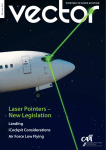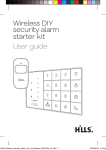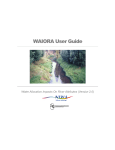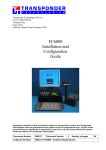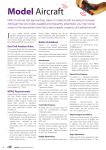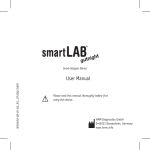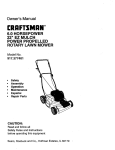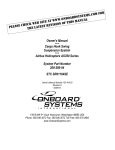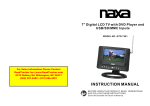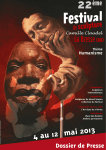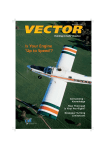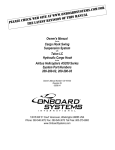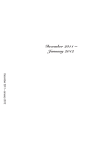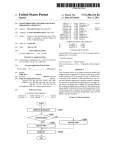Download Agricultural Aviation Safety - Civil Aviation Authority of New Zealand
Transcript
September/October 2013 vector POINTING TO SAFER AVIATION Agricultural Aviation Safety Flight Helmets are Good Insurance Wellington Airspace Changes Planning an Aviation Event In this issue... Post-incident Drug and Alcohol Testing3 New Approach for Agricultural Aviation Safety 4 9 A Sector Risk Profile on agricultural aviation has been developed and published in partnership with the Agricultural Aviation Association. We look at the profile and the 16 areas identified for action. Runaway Aircraft 8 Flight Helmets are Good Insurance 9 New Aeronautical Charts 10 It's More than Vector10 11 Flight Helmets are Good Insurance Planning an Aviation Event 12 Model Aircraft 14 A pilot’s recent encounter with a helicopter tail rotor has emphasised the value of a good flight helmet. We give some guidelines about care and maintenance. Remotely Piloted Aircraft 15 Model Aircraft and Privacy 15 Pilot Training for the Future 16 Obstructive Sleep Apnoea 17 Military Exercise 19 Backup Logbook Information 19 Night Flight Operations 20 New Avsec General Manager 22 Recreational Pilot Licence Changes 22 Guidelines for Small Aviation Organisations 23 National Airspace and Air Navigation Plan 23 How to Get Aviation Publications 23 Planning an Aviation Event? 23 Accident Briefs 24 GA Defects 26 Try our new search engine 28 Major changes to Wellington controlled airspace are coming soon. We highlight where the affected areas are and how this might affect your operation. Planning an Aviation Event 12 4 Changes for Wellington Controlled Airspace Changes for Wellington Controlled Airspace 11 New Approach for Agricultural Aviation Safety Start your planning early if you are planning an aviation event. It’s important to allow time because of the various requirements that may include approval from the Director, special airspace, and notification by AIP Supplement. Cover: A Grumman Ag Cat agricultural aircraft at work. See New Approach for Agricultural Aviation Safety on page 4. Published by Safety Promotion Unit of the Civil Aviation Authority of New Zealand, PO Box 3555, Wellington 6140. Tel: +64 4 560 9400, Fax: +64 4 569 2024, Email: [email protected]. Published six times a year, in the last week of every odd month. Manager Safety Promotion Bill Sommer. Editor Peter Singleton. The Vector Team Charlie Brimmicombe, Alister Buckingham, Lakshmi Guda, Mark Houston, Rose Wood. Design Gusto. 2 vector Publication Content Unless expressly stated as CAA policy, the views expressed in Vector do not necessarily reflect the policy of the Civil Aviation Authority. Articles are intended to stimulate discussion, and nothing in Vector is to be taken as overriding any New Zealand civil aviation legislation, or any statements issued by the Director of Civil Aviation, or the Civil Aviation Authority of New Zealand. Reader comments and contributions are welcome and may be published, but the Editor reserves the right to edit or abridge them, and not to publish those that are judged not to contribute constructively towards safer aviation. Reader contributions and correspondence regarding the content of Vector should be addressed to: Vector Editor, PO Box 3555, Wellington 6140, or email: [email protected]. September/October 2013 Free Distribution Vector is distributed automatically to all New Zealand flight crew, air traffic controllers, aircraft maintenance engineer licence holders, aircraft owners, most organisations holding an aviation document, and to certain other persons and organisations interested in promoting safer aviation. In the case of flight crew and air traffic controllers, a current aviation medical certificate must be held, and a current New Zealand address given, to ensure magazine entitlement. Holders of Pilot Certificates issued by Part 149 certificated organisations can also apply to receive a free Vector (see the CAA web site for details). Vector also appears on the CAA’s web site: www.caa.govt.nz. Change of Address Readers receiving Vector free of charge should notify [email protected] of any change of address, quoting your CAA Client Number. Paying subscribers should notify Vertia. Paid Subscriptions Vector is available on subscription only from Vertia, www.vertia.co.nz, email: [email protected], or freephone 0800 GET RULES (0800 438 785). Copyright Reproduction in whole or in part of any item in Vector, other than material shown to be from other sources or named authors, is freely permitted, providing that it is intended solely for the purpose of promoting safer aviation, and providing that acknowledgment is given to Vector. ISSN 1173-9614 Post-incident Drug and Alcohol Testing To aid the CAA's investigative processes, we need adventure aviation operators to submit post-incident drug and alcohol tests as soon as practicable. E very aviation occurrence gives the CAA valuable information that we can learn from, and subsequently, disseminate. exposition. It’s your responsibility to make sure that any employees working in safety critical roles are not impaired by drugs and alcohol,” says Rex. During this post-incident investigative process, we need to eliminate drugs and alcohol as a potential causal factor. Conducting post-incident testing will also allow you to identify employees who are in need of an employee assistance programme. Managing Risk Chris Hilson, New Zealand Drug Detection Agency (NZDDA) Chief Executive, highlights the importance of managing the risk associated with drug and alcohol consumption. “If you look at the NZDDA’s 2012 statistics, five per cent of the workplace post-incident tests we conducted in the transportation sector returned a positive result. Operators must have postincident testing procedures in place to isolate and mitigate the risks associated with drug and alcohol consumption in the workplace,” says Chris. In addition to post-incident testing, Part 115 operators must test for drugs and alcohol: »» before employment commences (when an individual is first employed or contracted) »» with reasonable cause during working hours if it is believed an individual may be affected by drugs or alcohol, and »» on a random basis. Operator Responsibilities Ed Randell, CAA Manager Health and Safety, explains that post-incident testing isn’t just crucial for your business; it’s important for the sport and recreation industry as a whole. Rex Kenny, Manager Special Flight Operations and Recreational Aviation, comments that it’s widely recognised by those in the adventure aviation sector that there’s no place for drugs and alcohol. “Fatal accidents have occurred in recreational aviation where drug usage has been detected. We now need to build confidence in the sector by showing that all operators are acting professionally. “As an adventure aviation operator, you must follow the post-incident testing procedures outlined in your company’s “We’re not trying to catch people out – it’s about trying to make sure the Part 115 system is seen to be credible. Operators must follow the drug and alcohol testing procedures that have been outlined in their expositions. “Ultimately, we want to make sure that anyone who gives adventure aviation activities a try, goes home safely,” says Ed. Third Party Testing The CAA recommends that operators enlist an independent accredited tester to conduct drug and alcohol testing. Although employers can perform the tests themselves to reduce costs, the results may be challenged if the tests are not performed accurately. If you need advice relating to drug and alcohol testing, contact the CAA Health and Safety in Employment Unit, email: [email protected]. ©istockphoto.com/ DNY59 vector September/October 2013 3 New Approach for Agricultural Aviation Safety A Sector Risk Profile has been developed in a partnership between the CAA and the Agricultural Aviation Association. The new approach to Safety Management Systems focuses on risk, and agricultural aviation is a high risk business. M ost aerial agricultural operations are flown in heavily laden aircraft, at low level in challenging terrain. Specialised equipment and highly skilled people are needed to operate this sector. Apart from the obvious operational concerns, participants are also subject to many other factors affecting safety. These include business performance, local weather conditions, and personal issues. Despite significant effort from the CAA and the aviation industry, the safety performance in this sector remains poor. The CAA and industry have agreed that a new approach to managing risk is needed. We have seen the development of Safety Management Systems, known as SMS, as a positive approach to safetyrelated risk. When in place, SMS structure ensures a proactive approach to risk identification and risk management. Risks can then be identified and treated before they lead to unsafe or dangerous outcomes. This is not only for safety, but also for business enhancement. SMS is part of a global change to how regulators carry out their obligations – 4 vector September/October 2013 risk-based regulatory oversight. Risk-based Regulation The CAA is committed to the concept of adopting a risk-based approach to regulatory oversight. This is in line with International Civil Aviation Organisation (ICAO) requirements for regulatory bodies to develop a State Safety Programme (SSP). The development of the SSP will be in accordance with ICAO Annex 19 Standards and Recommended Practices. This includes the implementation of a formal SMS by aviation organisations. John Kay, CAA General Manager Policy and Systems Interventions explains what this means for the agricultural aviation sector, and the CAA. have a structured means to effectively use resources. This ensures that the highest risk sectors of industry will be managed first. “This is one of the main reasons why the agricultural aviation sector was selected to undergo a Sector Risk Profile,” said John. About the Sector Risk Profile A Sector Risk Profile (SRP) is an effective tool that CAA and industry can use. It is designed to focus resource and effort towards areas of the industry of greatest risk. “The aviation industry is dynamic and safety-risk factors also change. Without ongoing effort, there is a potential for risks to increase due to factors such as introducing new technology, and commercial pressures. For the agricultural aviation SRP, an independent company was commissioned to develop the profile. They conducted extensive research, and a review of historical documents and data. They also conducted personal interviews with CAA staff, industry representatives, industries that support agricultural aviation, and farmer clients. “The regulator and aviation organisations need to employ a riskbased approach to safety management. From the collected information, a report was produced that identified a number of risks. “One of the main objectives of riskbased regulation for the CAA, is to Operators are responsible for managing their own risk. The SRP Photo courtesy of Craig Hayden enables them, and the CAA, to now have an accurate understanding of the risks attached to their businesses. With this information, both groups can work together to set safety performance goals, and reduce risk. What Are These Risks? Risk can be defined as the chance something could happen, and risk management as the identification of safety risks enabling proactive control of the potential outcome of these risks. Sixteen risk elements have been identified in the agricultural aviation SRP. The report has placed them into risk levels ranging from Medium to Very High. These levels are determined by assessing the likelihood of the risk occurring and the possible consequences. Examples of identified risk elements include aircraft performance and maintenance; operator obligations; pilot training; and airstrip conditions. Steve Kern, CAA Manager Helicopter and Agricultural, talks about the SRP process to date. “The SRP has been a valuable step to look into the agricultural aviation sector. It certainly gives us a focus for tackling risk and improving safety. “We are due to meet with industry to discuss the next steps. The essential elements of the SRP were delivered to the New Zealand Agricultural Aviation Association (NZAAA) Conference in June. We have had a lot of feedback and discussion from this presentation,” said Steve. How Will the Risk be Reduced? The report provides the risk statements and likely consequences. It also shows treatment strategies. These detail relevant ideas for all SRP parties to use as the basis for developing ways to reduce the attached risk. The reduction measures will need to be further developed into actual tasks that can be carried out. Systems will then need to be developed to track the work results, provide resource as required, and establish timeframes for completion of tasks. contributed to the SRP process. Further work was carried out during workshop sessions at this year's Conference. This allowed pilots, management to loader work drivers, and together on identification of risks. John Sinclair is an experienced aviator and helicopter operator. He is part of the NZAAA team involved in the risk profiling. Here he discusses the SRP process from an industry perspective. “The risk-based approach to regulation is a new and logical step for industry. It is a better way for us to deal with issues affecting our business operations. Risk assessment, and risk management are not unknown to the agricultural sector. We have known of those factors that greatly affect us. Just how we have Steve Kern explains, “From the meeting with industry, we hope to prioritise the reported risks and treatments. From this we will set targets for completion of the many tasks required. managed them is the likely question. We “Obviously, we cannot mitigate all the risks at once. For a start, we will look at five or six risks that we can realistically all work on,” he said. work closely with the regulator on the An Agricultural Aviation Sector View The NZAAA is a co-sponsor of the SRP and, along with other members of the agriculture industry, has actively have embraced QMS in the past, and now look forward to SMS. “The relationship between CAA and NZAAA is very good and the ability to risk reduction programme will have positive outcomes for our safety. We have our role to play and the CAA has theirs. “We also enjoyed working with the contractor developing the SRP, and they have valued our experience and input too,” said John. Continued over vector September/October 2013 » 5 Photo courtesy of Dan Retief FIGURE 7 C Current Risk Profile Likelihood Consequence EXTREME CERTAIN LIKELY POSSIBLE VERY HIGH VERY HIGH HIGH VERY HIGH HIGH HIGH CRITICAL 1 2 HIGH MAJOR 5 HIGH MINOR Other Sectors FIGURE 7 Aviation P The agricultural sector has already endorsed the value of a strong, independent look at how their businesses manage risk. 3 4 7 8 CONSEQUENCE 6 vector September/October 2013 MEDIUM 11 12 13 14 15 16 MEDIUM LOW MEDIUM LOW “We are seeing the strong move to risk- John Kay sees the strong interaction based assessment and regulation in the with industry as a positive sign. aviation industry. This is evident with the promotion of the implementation of Safety Management Systems into our LIKELIHOOD businesses. The Sector Risk Profile is ourselves,” said Graeme. MAJOR 10 MEDIUM Their Sector Risk Profile is the first an integral part of this move. in an extensive programme. CERTAIN “It is about seeing theLIKELY risks and changing Other sectors of the New Zealand our behaviour to develop a strong safety aviation community will soon undergo culture and environment. The SRP gives participation in their own sector us focus. We can then see all the risk profile. EXTREME VERY HIGH (1) VERY HIGH (2) significant risks and issues affecting us Graeme Martin, Chairman of the and what we need to do to reduce or Aviation Industry Association board, eliminate them. We now have the ability and Immediate Past President of the to treat the symptoms. NZAAA, sees the SRP process asVERY a HIGH (3) CRITICAL HIGH (4) “We must have a safe operating great opportunity for the aviation environment for our customers and industry to engage with all participants, and the CAA. HIGH 9 HIGH 6 UNLIKELY HIGH (6) HIGH (7) “The agricultural sector was chosen to start the SRP process. So far, we have seen strong engagement from this industry to make the process work. “We look POSSIBLE forward to working closely UNLIKELY with the agricultural industry in the future, and helping them achieve a reduction of risk. This is the desired outcome environment,” HIGH (5) – a safe aviation HIGH (9) said John. For further reading see Vector, SMS HIGH (8)in the July/August MEDIUM Update, 2013(12) issue. You1can see the Agricultural 3 10Aviation Sector Risk Profile on the CAA web site, www.caa.govt.nz. MEDIUM (11) 2 4 5 6 7 8 9 LOW (15) MEDIUM (14) 11 12 The 16 Risks Identified in the Agricultural Sector Risk Profile No. Risk Statement Risk Level 1 Some operators choose to selectively comply with the multiple regulatory requirements (ie, environmental, HSE, commercial, and aviation requirements), creating opportunity for safety failures where regulations have not been met but no other control measures are implemented in their place. 2 Regulatory oversight may not adequately identify critical risks or issues that then result in safety failures in the agricultural aviation sector. 3 Due to an absence of industry-agreed, best practice operational standards, agricultural aviation activities are not conducted with consistency across the sector, resulting in an overall degradation in safety performance across the sector. 4 The maintenance and operational management of agricultural fixed-wing aircraft as an asset can be insufficient for the type of role it undertakes over the span of its life, leading to an aircraft with reduced safety margins or airworthiness assurance. 5 As a result of commonly-used ‘industry pricing models’ that are used to attract customers, operators undercut competitors to the extent that within that region all operators become financially unstable, leading to operational behaviour that sacrifices safety for short-term profitability. 6 The financial stability of all operators is reduced by the trend towards a prevalence of smaller, inexperienced helicopter operators with minimal financial outlay entering the sector and charging reduced rates for market share. 7 Degraded aircraft performance due to routine overloading of aircraft is prevalent amongst agricultural aviation operators, leading to unsafe operating margins and a higher risk of an accident. 8 There is an overarching safety culture within New Zealand agricultural aviation where productivity is prioritised over safety (ie, the ‘can do’ approach), where safety equipment is not always utilised, and where safety occurrences may not be reported. 9 Due to the absence of consistent and robust sector training standards, the skills and knowledge of agricultural pilots and instructors vary significantly throughout the sector, leading to a degradation in overall ability to safely undertake agricultural operations. 10 As a result of increasing community awareness and concern regarding environmental matters, the viability of aerial application as a farming tool may be threatened if public perception is not actively managed, leading to the cessation of agricultural operations. 11 Current agricultural aviation legislation allows for operational practices that reduce aircraft safety margins, including the ability to carry higher than normal loads without documenting the necessary conditions under which this can be done. MEDIUM 12 As a result of helicopter operator numbers increasing, there is a higher chance of the under-reporting of hours to avoid maintenance of high-value equipment to occur due to pressures to reduce business costs. It will also lead to crew with less agricultural aviation experience. MEDIUM 13 Operators’ safety margins are reduced due to the condition of some owners’ airstrips and the supporting infrastructure (ie, fertiliser storage, windsocks, etc.) MEDIUM 14 Poor fertiliser storage facilities and methods (as well as fertiliser properties that can be conducive to degradation) and lack of consistently identifiable physical properties, aircraft can be loaded with a degraded or unknown condition of fertiliser, which can result in operational unpredictability when releasing it. MEDIUM 15 While industry accreditation programmes provide an opportunity for operators to improve, the perception of their value has degraded as they are often viewed as an arbitrary exercise to retain clients (that require the accreditation), resulting in a reduction in the benefits that could come from present and future programmes. MEDIUM 16 As a result of what can be a low maturity of safety management amongst some operators, there are few incentives for operators to systematically manage fatigue, distraction and enhance non-technical skills, thereby increasing the potential of poor safety outcomes during daily operations. MEDIUM vector VERY HIGH HIGH HIGH HIGH HIGH HIGH HIGH HIGH HIGH HIGH September/October 2013 7 Photo courtesy of Aviation Cooperating Underwriters Runaway Aircraft A pilot left a helicopter running while he went to talk to his ground crewman. He then heard the engine rpm increase. Running back to the machine, he could only watch as it lifted into the air, spun around, and came to rest in a nearby pine tree. L eaving an aircraft unattended with the engine still running, and rotors or propeller turning, increases the risk of the aircraft taking off without you. It also increases the risk of injury to yourself, your passengers, or other people nearby. Then there is the cost. Not only the replacement cost, but also the possibility of increased insurance premiums, or difficulty insuring at all. Arden Jennings from Aviation Cooperating Underwriters is very familiar with this type of accident claim and the resulting insurance issues. “Some countries in the world do not permit the pilot to leave the aircraft flight controls unless the engine and rotors or propellers are stopped,” he says. “A number of helicopter manufacturers also include advice in the Aircraft Flight Manual and Pilot Operating Handbook, against leaving the aircraft unattended when the engine is running. “But accidents still happen and most of the insurance cover for New Zealand aircraft is based on operations being conducted under the Civil Aviation Rules,” says Arden. Currently, there is no restriction on leaving a running aircraft unattended in the Civil Aviation Rules. 8 vector September/October 2013 However, you are required to comply with any operating limitations specified in the Aircraft Flight Manual. Helicopters in the past 20 years, aircraft moved under their own power on level ground. In either case, this can leave the pilot with a lonely, desperate chase that often results in a broken aircraft. Although there are a number of factors that may have caused the loss of 13 runaway helicopters in the last 20 years, in most cases, the machines were unattended. If you are going to leave your aeroplane, use wheel chocks. In remote areas you might need to improvise with material that is available. When busy on operational flying, pilots think they are saving time and money by leaving the machine running. Turbine pilots are influenced by engine costs and component life. Other instances of runaway aircraft accidents include factors such as uneven terrain, snow landings, controls being knocked by passengers, and poor operational decision making. Fitting and using an approved collective lever lock or catch when stepping out of the machine, should prevent the lever rising and reduce the risk of the aircraft lifting off unattended. We have discussed this type of event before in an article, “POB Ø”, in the March/April 2009 Vector. Using only the friction knobs to lock the flight controls is not advised as they are not intended for this purpose. Talk to your maintenance provider about approved collective locks, check your SOPs for leaving a running aircraft unattended, and revise the correct techniques for parking your aircraft. Aeroplanes If you leave the aircraft running, remember that a combination of idle thrust and sloping surfaces can produce a force that may override the brakes. But in some of the nine runaway aeroplane accidents recorded Examples of helicopter runaways are also found (too often) in the “Accident Briefs” section of Vector. Then ask yourself about the decision, and possible cost, of turning your back on an unattended, running aircraft. Making the right call will save you time and money, and will let you enjoy flying with your aircraft. Photo courtesy of Dan Perriam Flight Helmets are Good Insurance Prevention of head injury is the main purpose of a flight helmet. A helicopter pilot’s recent experience certainly bears that out. Lucky Escape Helmet Care and Maintenance n unattended Robinson R22 became airborne of its own accord while the pilot was outside the cockpit, but in the immediate vicinity. He heard an increase in engine noise and turned around just in time to be clipped by the tail rotor as the machine swung around. A new helmet should be sized and properly fitted by a trained technician. There are numerous considerations, such as how high the helmet sits on the head, the adjustment of the internal harness, additional padding between the earphone assemblies and the outer ear cups, and the tightness of the nape strap. A Fortunately, the pilot was still wearing his helmet, and the accompanying photo amply illustrates what a lucky escape he had. Without the helmet, this would have been an almost certain fatality. Protection Mechanisms The helmet shell is designed to resist penetration and prevent direct damage to the skull. In this case, the shell was partially destroyed and absorbed most of the shock of the blow. Additionally, the helmet spreads the force of a blow over a wider area, and will reduce point forces to a tolerable level. A helmet shell is typically lined with a crushable foam insert, as well as being suspended on the head by an internal harness that provides clearance between the wearer’s head and the helmet structure. In the event of an impact where the head strikes an immovable object such as an instrument panel, the partial destruction of the helmet shell and the crushing of the interior foam lining can reduce the acceleration forces experienced by the brain to a survivable level. In an accident resulting in a fire, the maintenance of consciousness is critical to survival. Some models may also provide for variation of the chinstrap position. If this is incorrect, the helmet may be lost in the early stages of an impact sequence. In a fatal agricultural accident investigated by the CAA some years ago, the pilot’s helmet, undamaged and with the chinstrap still fastened, was found about three metres to the front of the burnt-out wreckage. If a trained technician is not available, carefully follow the instructions in the helmet handbook, and heed all listed cautions and warnings. The handbook will normally specify maintenance intervals and instructions, as well as giving guidelines as to unacceptable limits of damage, particularly to the outer shell. In the event that a helmet is damaged to the point of unserviceability, either complete the destruction, or quarantine it, so that it will not be mistakenly worn by someone else. A flight helmet is a highly technical piece of safety equipment, and the price will reflect that. In the event of an accident where a helmet performs as advertised, the replacement cost may not be included in the aircraft insurance. Insuring your helmet separately might be a wise move – it could be included in your household contents as a listed item, for instance. If it saves your life, then it has paid for itself many times over. vector September/October 2013 9 New Aeronautical Charts The 2013 Visual Planning Charts and Visual Navigation Charts are effective 14 November 2013. T he most significant changes this time are the altered CTA boundaries in the Wellington area, as described on the next page. Other changes include the usual updates to special use airspace throughout the country, and these include danger areas, general aviation areas, volcanic hazard zones, and low flying zones. Charts can be ordered now, either online from www.aipshop.co.nz, or by contacting Airways’ Aeronautical Information Management (AIM) team, tel: 0800 500 045. www.aipshop.co.nz It’s More than Vector T hanks for letting us know your new address – we get a flurry of messages after every Vector mailing. But the wording of the emails clearly shows that many do not understand the legal obligations of holding a New Zealand aviation document. Section 8 (2) of the Civil Aviation Act 1990 requires every applicant for a New Zealand aviation document to supply an “address for service” in New Zealand including, where applicable, telephone and facsimile numbers. The Act also requires aviation document holders to notify the Director promptly of any changes to the address for service, telephone number or facsimile number. You can do this by emailing [email protected]. An “address for service” is a physical address. You can have mail sent to a different address if you like, but maintaining a current physical address for service with the CAA is a legal requirement under the Act. This applies to both individuals and organisations, whether based in New Zealand or overseas. The requirement is specified on relevant application forms. If you live overseas, or plan to relocate overseas, you must nominate a physical address in New Zealand. This could be the address of a lawyer, a family member, or an aviation organisation. In doing so, you accept that delivery to that address is formal notification for the purposes of the Civil Aviation Act 1990. If you use a separate postal address, that can be a New Zealand address or an overseas address, but be aware that Vector magazine is sent only to New Zealand postal addresses. Applicants under the Trans Tasman Mutual Recognition Act also need to comply with the Civil Aviation Act 1990, and the relevant forms ( 24061/09 and 24061/10) reflect this. You also need to advise other organisations that you do business with, of your change of address. If you subscribe to AIP New Zealand, for example, you need to contact Airways. If you operate an aircraft with a 406 MHz distress beacon, you must notify RCCNZ of any changes to your contact details. 10 vector September/October 2013 NOT FOR OPERATIONAL USE Changes for Wellington Controlled Airspace Major changes to Wellington controlled airspace may affect your flight operations around Paraparaumu, Marlborough Sounds and Woodbourne. W ith effect from 14 November 2013, the new charts will show airspace boundary changes and, in some cases, a lowering of the upper limit of the Wellington Control Area (WN CTA) from 5500 feet to 4500 feet. The changes are to allow for more efficient use of Wellington airspace, especially by airliner traffic operating into Wellington, Paraparaumu, and Woodbourne. The most significant changes are in the Paraparaumu area where a new airspace boundary is formed to the east of NZPP. On the eastern side of this new airspace, the lower limit is retained at 5500 feet, with the western side lower limit now set at 4500 feet. This 4500 feet lower limit now extends across Cook Strait to the north-eastern edge of the Marlborough Sounds. A further amendment to the boundary of this controlled airspace sees it move to the east. There is also a step down to 4500 feet with some straightening evident. This change was included as part of a separate request from the local user group. This also affects the boundary of the Marlborough Sounds CFZ, with a move inland towards Mount Dobson. Rununder Point and Port Underwood are now included in the new step down area. The third area sees a step down in the area seaward of Cape Campbell. This provides for traffic from the south going to Wellington or Woodbourne. All the new airspace is Class C and transponder mandatory (TM on the charts). Paula Moore, CAA Aeronautical Services Officer, is responsible for airspace classification and designation. As an experienced air traffic controller, she provides further information on the use of the affected airspace. “These airspace changes, including the step downs, will allow better descent profiles for jet aircraft with a significant reduction in fuel burn. There should also be a significant reduction of workload for both pilots and air traffic controllers. “After the changes take place, remember that to transit Cook Strait above 4500 feet, you will need an ATC clearance. “When requesting a clearance, be confident. Advise your position and intentions clearly and concisely, and don’t forget to read back the instructions. ATC will help you as much as they can at the time, but it is busy airspace,” Paula says. Charting Information The charts affected by the changes are: VPC A1 and A2, and VNC B2, B3, C2, and C7. Relevant Enroute and Lower North Island and Upper South Island Area Charts will incorporate the changes too. Order your VNCs now, and familiarise yourself with the differences. How to order is on the previous page. vector September/October 2013 11 Planning an Aviation Event If you’re planning any kind of an aviation event, from a simple fly-in to an air display, you’ll need to consider if it fits the Part 1 definition, and whether it requires the Director’s approval. One of the most important things is to start your planning early. T here are many events when several aircraft gather, such as a club barbecue, competitions between clubs, dawn visits, and so on. The public is often present, simply because the airfield is a public place and they like to watch, or sometimes for a specific reason, such as an open day. And there are events where organized flying displays take place. But what makes any of these an ‘aviation event’, and what does that mean anyway? What is an Aviation Event? There can be some confusion, because there are different requirements for various events. We’ll try to make it easier for you. Authorisation Required The Part 1 definition (see panel on right) of an Aviation Event is based on low flying, so mostly involves airshows and aerobatics. Rule references to an 12 vector September/October 2013 aviation event relate to this definition. It’s Easy to Apply Events that fit the Part 1 definition require an authorisation from the Director, but there are some exceptions. See below. There’s an Advisory Circular, AC91-1 Aviation Events that provides information to help you. Even if your event doesn’t require an authorisation, it is recommended that you follow the guidance in the AC. Rule 91.703 Aviation events details what information you must supply in your application for authorisation. This must be submitted at least 90 days before the event. Some Part 149 organisations hold a delegation from the Director to authorise their own events, or to authorise events for other organisers. The New Zealand Warbirds Association holds such a delegation. Authorisation Not Required You do not require an authorisation if your event doesn’t fit the Part 1 definition. Also, rule 91.703 provides some conditions where an authorisation isn’t required (see panel on right) If you have any doubt, just contact the CAA (see email address below). Jeanette Lusty, CAA Team Leader Flight Operations Adventure Aviation, processes the event authorisation applications. “We have these requirements around aviation events to ensure public safety and this is in the interest of the event organisers as well. “Most events are repeated, so once the procedures are developed, it becomes easier. “The AC is really helpful for applicants as it contains a detailed Planning Guide and Risk Assessment Guide. “Make sure you send in as much relevant and detailed information as you can, in line with the AC. We put this information through a risk identification process to get a picture of the risks and how they will be addressed. “And if you are unsure about anything at all, just ask us,” says Jeanette. Email: [email protected]. Apply using CAA Form 24091/03, available on the CAA web site, www.caa.govt.nz, “Forms”. Airspace Considerations Your event may also need airspace restrictions to be put in place. These enable the organisers to control who is able to fly into, out of, and within the airspace during the time of the event. Consult with local airspace users and your aerodrome operator before making this application. The aerodrome operator’s consent is required for airspace restriction. A separate application needs to be made for airspace. Use CAA Form 24071/01 and email: [email protected]. If you are unsure whether you need special airspace put in place, contact the CAA Aeronautical Services Unit at the same email address. Special airspace applications should also be made at least 90 days in advance, giving time to publish the details in an AIP Supplement. Practice days should also be included in the application. Even if you are not applying for special airspace use, it is recommended that you arrange for your event details to appear in an AIP Supplement to alert other airspace users. AIP cut-off dates are published in every issue of Vector (see page 23). Email: [email protected]. It is inappropriate to use a NOTAM for pre-planned events such as these. A NOTAM should be used only for situations of an urgent and temporary nature, such as an unforeseen aerodrome closure or significant hazard. Low Level Display Authorisation Event organisers also need to ensure that all pilots who participate in any sort of aviation event are appropriately rated and qualified. All pilots who wish to fly low level or aerobatics at aviation events must hold a low level display authorisation (LLDA) issued by a Part 149 organization authorised for this purpose, such as the New Zealand Warbirds Association. Pilots should have had appropriate ground and flight training in the manoeuvres they are to perform at the event, to be able to qualify for an LLDA. John Lanham, display pilot and former CAA General Manager General Aviation, has been involved in military and civil aviation events for many years now. “The Director has delegated his authority to specific senior persons in the New Zealand Warbirds Association to grant LLDAs to pilots who are to participate in an airshow. “The event organiser has the power to withdraw the participation invitation extended to any pilot if the pilot is noncompliant with required standards of safety. “If there are concerns about a pilot’s attitude to safety, the LLDAs may be suspended for any period or withdrawn by the delegation holders in the event of non-compliant flying.” John has a few tips for event organisers. “It is important to remember that exception from rule 91.311 is applicable only to aircraft being operated at an aviation event. “And even while participating in an aviation event as defined by these rules, it is important to remember that aircraft are not allowed to fly below 100 feet above the surface. The only exceptions are during takeoff or landing, or unless it is a display of agricultural operations, or a helicopter operation,” he says. Excerpt from Part 1 Definitions and Abbreviations Aviation event means an event to be conducted below the minimum safe heights prescribed under Part 91 that is— (1)an air show or practice for an air show; or (2)an air race or practice for an air race; or (3)an aerobatic competition; or (4)aerobatic training or practice: Excerpt from rule 91.703 Aviation events (e) Paragraph (a) shall not apply to aviation events at which— (1)not more than 500 people are in attendance; or (2)there are no more than three participating aircraft; or (3)the aircraft are in one formation. vector September/October 2013 13 Model Aircraft With Christmas fast approaching, sales of model aircraft are likely to increase. Although they are widely available and frequently advertised, you may not be aware of the associated rules that protect people, property, and piloted aircraft. I f your model aircraft weighs between 100 grams and 25 kg, you need to be aware of the following Civil Aviation Rules and Model Flying New Zealand (MFNZ) requirements. Key Civil Aviation Rules Civil Aviation Rules, Part 101, prescribes the operating rules for model aircraft. Part 101 requires you to operate your model aircraft in a safe manner so that it doesn’t create a hazard to aircraft, persons and property (rule 101.13). Always read the user’s manual and follow the manufacturer’s instructions. In addition: »» You can’t drop objects in flight if this creates a hazard (rule 101.15) »» You must maintain line of sight with the model aircraft (rule 101.209) »» All other manned aircraft have the right of way (rule 101.213). To view Part 101, see the CAA web site, www.caa.govt.nz, “Rules”. MFNZ Requirements Model Flying New Zealand is currently the only model aircraft association approved by the Director of Civil Aviation. MFNZ inspects models and issues flight permits to members, allowing them to operate in accordance with their operations manual and procedures. Some MFNZ Requirements: »» Radio controlled models with a gross mass between 15 and 25 kg require a MFNZ permit to fly (It’s illegal to fly without one – reflected by rule 101.205). They must also be constructed under the authority of MFNZ. »» Models weighing less than 15 kg that have internal combustion motors 75 cc input or larger, or electric motors 5,000 watts input or larger also require a permit to fly. 14 vector September/October 2013 Those models weighing over 25 kg require additional CAA authorisation to fly under Civil Aviation Rules, Part 19. Safety Guidelines Reports of airspace incursions involving model aircraft demonstrate the need for owners to understand the following rules. 400 feet above ground level when you are within 4 km of an uncontrolled aerodrome boundary – unless authorisation has been granted by the Director of Civil Aviation. To apply for an authorisation email: [email protected]. Unless stated otherwise, these rules do not apply to control line model aircraft. When operating a model more than 4 km from an aerodrome boundary, you can fly higher than 400 feet only if you remain clear of all controlled airspace and: Aerodromes »» operate in a designated danger area (model aircraft/UAS), or You must not operate a model aircraft on or within 4 km of any aerodrome unless the operator has received a ‘Wings’ badge from MFNZ, or is accompanied by someone else that holds one. You need to get prior authorisation from the aerodrome operator, and at a controlled aerodrome, from the relevant ATC unit. For aerodrome contact details, see the Aeronautical Information Publication (AIP) web site, www.aip.net.nz, “Aerodrome Charts”. Once you have authorisation, you must not operate your model over any active runway strip area, or any area that aircraft use for surface movement (control line model aircraft must also remain clear of these areas). Controlled Airspace By lifting off from your back yard, you could be unintentionally infringing controlled airspace. To operate in controlled airspace, you need to receive prior authorisation from the responsible Air Traffic Services (ATS) unit. To view a list of controlled aerodromes and their contact details, see the AIP web site, www.aip.net.nz, “Gen 3.3 – Air Traffic Services”. Section 6 contains an ATS Unit Address List. Height Restrictions You can’t fly your model any higher than »» an authorised person from MFNZ provides the required information listed in rule 101.207 to the New Zealand NOTAM Office. Special Use Airspace To operate in a mandatory broadcast zone, a model aircraft operator must maintain a listening watch on the appropriate frequency and communicate any intentions to other traffic in the zone. In addition, model aircraft can’t operate in low flying zones. The same goes for restricted areas and military operation areas – unless prior authorisation has been granted by the administering authority. Airspace characteristics and designations can be viewed on the Visual Navigation Charts. To purchase these charts see the Airways web site, www.aipshop.co.nz. Meteorological Conditions To fly your model aircraft, the ground visibility must be 3 km or greater and the model must remain clear of cloud. In addition, you can’t fly your model aircraft if the cloud base will prevent you from maintaining sight of the model at all times. Night Operations Model aircraft can be operated at night only if they are flown indoors, or if the flight is conducted outdoors within 100 m of a structure, and below the top of the structure. ©istockphoto.com / andsem / robertmandel / temizyurek Privacy Many model enthusiasts are now fitting cameras to their models, and new types are frequently sold with cameras fitted. If you are using a camera, you need to check that you are in compliance with privacy laws. See the Privacy Commission web site, www.privacy.org.nz. Join a Club Seventy five model aircraft clubs operate nationwide. Become a member to take advantage of local knowledge, learn about safe operating practices, and get a better understanding of rule requirements. See the MFNZ web site, www.modelflyingnz.org, for club contact details and MFNZ requirements. If you have a query regarding model aircraft, email: [email protected]. Air Swimmers: These are not classed as model aircraft. Please follow the manufacturer’s instructions and keep them indoors. Radio Controlled Aircraft: The majority of models fall into Control Line Aircraft: These motorised aircraft are controlled solely by using one or more inextensible wires or cables directly connected to the model. The wire system can’t be longer than 30 m. the model must be maintained at all times. Small toys of less than 100 grams: These are not classed as model aircraft and Civil Aviation Rules do not apply. Model Gliders: Lift is generated solely by the external this category. These are primarily controlled by radio signals from a remote transmitter, and direct visual line-of-sight with Free-flight Aircraft: A model aircraft which, once launched, can no longer be controlled by the operator. aerodynamic forces acting on the aircraft. Remotely Piloted Aircraft M any remotely piloted aircraft, suitable for aerial photography We’ve covered model aircraft on surveillance, use rules, please contact the CAA sophisticated technology that with details about your planned wasn’t even dreamed of when operation. and our rules were written. Aviation regulators worldwide are grappling with the risks and safety issues associated with The current ICAO name for such is Remotely Piloted Aircraft Systems (RPAS). Over time, many terms and acronyms have been used for these aircraft, such as Unmanned Aerial Vehicles want to fly outside the Part 101 It may be that you need an authorisation under Part 19, issued by the Director. For that to happen, the Director these aircraft. aircraft the previous pages, but if you and Systems (UAV and UAS). The CAA has a responsibility to ensure public safety and this comes to the fore when operators want to fly in urban areas. must be assured the proposed operator has potential examined risks and the made provisions for safe operation of the aircraft. Contact the CAA for guidance, email: [email protected]. In the future, more specific provision will be made for pilotless aircraft activities as we update the relevant rules. Work is already under way on this. Model Aircraft and Privacy M odel aircraft and remotely piloted aircraft have the potential to be intrusive when fitted with cameras. Organisations or individuals using such aircraft would have to have a very good reason for collecting personal information in the form of photographs and video, and we would expect them to take care on how the images were used and who they were disclosed to. We would expect users to think through the privacy implications of what they intend to use them for. In this regard, many of our guidelines for CCTV use would also apply in many situations in which aircraft are used. To see those guidelines, go to www.privacy.org.nz and enter “privacy and cctv” in the search window. - Office of the Privacy Commissioner vector September/October 2013 15 Kiran Parbhu, a flight instructor from Massey University’s School of Aviation, gave a presentation to the seminar on Massey’s research into using the iPad in the cockpit. Photo courtesy of Massey University School of Aviation GEN 2.7 -2 1.2 Daylig AIP New 1.2.1 ht Zo Zeala nes, in Fig The da North nd ure yli Island GEN ght zon 2.7-1. es for the North Islan d of New Dayli Figur Zeala e GE ght nd are Zone N 2.7 s, No -1 depic rth ted Islan d Effect ive: 12 FEB 09 E Civ il Avi atio n Aut hority Pilot Training for the Future Seventy-five attendees at the recent CAA Flight Instructor Seminar in Wellington saw new training ideas and instructional techniques. Then they saw the future – iPad technology in a paperless training cockpit. K iran Parbhu, a flight instructor from Massey University’s School of Aviation, outlined the considerable research they have been conducting on the use of the iPad. Even though the electronic flight bag concept is well advanced in many airlines, Kiran explained how the technology works for flight training and GA operations. “We trialled the iPad and mini iPad for flight training capabilities. Instructors and students provided feedback that we used to determine their suitability. “With the ability to store maps, charts, and AIP New Zealand on a mini iPad, the information management was improved through easier access. Power usage, lockout, and background light effects were some of the points raised. Interestingly, it was calculated that 36 kilograms less paper is required when information is stored on a tablet! 16 daily lives, and some people are more familiar with it than others. The discussion after this presentation was about current applications, and what can be done now to secure the future of flight instruction and pilot training. Carlton Campbell, CAA Standards Development and Training Officer, guided the seminar and introduced a review of the AvKiwi topic of Situational Awareness. Attendees worked in groups on many tasks and presented their findings to the seminar. Stan Smith, pilot, engineer, and flight instructor, showed a self-made film about pre-flight inspections. He also discussed the requirements for maintaining instructor skills and a professional approach to pilot training. “The future will be paperless; the machines will be smarter, lighter, smaller, cheaper and fast; yet the trial showed that most pilots still prefer paper maps. Although ancient technology, they are easier to handle and navigate with,” said Kiran. Gordon Alexander and Graham Leach from Aviation Services Limited talked about flight testing and candidate preparation. The message was to be well prepared for groundwork and the flight. They both stressed the basic need for a candidate to be professional, achieve high standards, and maintain high levels of airmanship. There was a large spread of ages and experience present at the seminar. Smart technology is now a part of our Ross Crawford, a very experienced pilot and flight examiner, then explored the concepts of teaching and the principles of vector September/October 2013 learning. An interesting workshop followed using the same groups as before. The subject was initial pre-flight briefings. The groups were asked to evaluate the lessons for key points in the learning process, and report these findings to the seminar. Mike Haines, CAA Manager Aeronautical Services, talked about radio use in uncontrolled airspace and raised a number of safety issues. The use of FISCOM, CFZ proposals, and continued use of 119.1 MHz at uncontrolled aerodromes were raised as issues. Feedback from the industry was positive and valuable. To close the day, Carlton recapped the proceedings and reinforced a number of the points raised. »» The main message is that as an instructor you are not teaching a student to fly, you are training a pilot. »» Demand the highest standards of yourself and your students. »» Enjoy! The CAA-sponsored seminars also ran in Christchurch and Auckland and are a welcome and valuable experience for all instructors, and for those wanting to become a pilot training specialist. Obstructive Sleep Apnoea You may not think that snoring is something you should be overly concerned about, but if you are a frequent loud snorer, you could be suffering from a potentially serious sleep disorder, Obstructive Sleep Apnoea (OSA). Asleep at the Yoke I n 1994, the lone pilot of a Piper Seneca fell asleep while enroute from Springfield, Kentucky, to Crossville, Tennessee, in the United States. When he awoke five hours later, he was over the Gulf of Mexico, 210 miles south of Panama City. Only 20 minutes of fuel remained. While enroute to the nearest airport, the engines quit due to fuel exhaustion and the aircraft was ditched. The pilot was rescued by a Coast Guard helicopter. The pilot of the Piper Seneca didn’t understand the risks associated with sleep deprivation, and failed to recognise the warning signs prior to the flight. Sleep deprivation is usually thought about in terms of quantity of sleep. This can be managed through a comprehensive Fatigue Risk Management System. But OSA affects sleep quality rather than sleep quantity. What is OSA? When you sleep, all your muscles relax, including the muscles that hold the respiratory passages open. In some people, the airway becomes narrow enough that breathing causes the respiratory passage to vibrate and make noise – also known as snoring. Apnoea is a medical term that means ‘being without respiration’. An apnoea occurs when the airway becomes partially or completely shut while asleep. During an apnoea, breathing briefly pauses or becomes very shallow. The person will continue to sleep ©istockphoto.com/ humonia vector September/October 2013 17 ©istockphoto.com/ robroxton During sleep, the airway can become blocked by the tongue and soft palate. even though they are struggling to breathe. Nasal cavity Chin Eventually, the need to breathe will overcome the ability to stay asleep. In most cases the person won’t fully wake up, but they will leave a state of deep sleep and enter a state of lighter sleep. This allows the muscle tone in the throat to return, unblocking the airway. Tongue Upper lip These pauses can occur hundreds of times a night, and when they do, the medical condition is termed OSA. This is one of the most commonly diagnosed sleep disorders internationally and is estimated to affect two per cent of women and four per cent of men. Soft palate The repetitive brief arousals caused by OSA lead to the same effects caused by sleep deprivation. Those suffering from OSA will experience daytime sleepiness, along with impaired reflexes and concentration. Most people with OSA are overweight, and have higher deposits of fatty tissue in their respiratory passages. Obstruction If you answered “yes” to one or more of these questions, you are at a higher risk of having OSA and should consult a doctor. impairment level closely resembled a blood alcohol content of 0.10 per cent – too drunk to drive (New Zealand’s limit is 0.08 per cent) and unfit to fly. Other symptoms include: »» Waking up with a dry mouth or sore throat There are also serious health implications. If left untreated, OSA can lead to health problems, including: »» Insomnia or night-time awakenings »» High blood pressure »» Mood changes and irritability »» Stroke »» Anxiety and depression »» Forgetfulness »» Heart disease (30 per cent increased risk) »» Decreased sex drive »» Weight gain and obesity Your answers to the quiz below will help you determine if you are an OSA sufferer: »» Unexplained weight gain »» Diabetes »» Heartburn »» Clinical depression. »» Night sweats. What’s Your Snore Score?* »» Do you feel tired or groggy on awakening, or do you awaken with a headache? Although chronic snoring is the most common symptom of OSA, not everyone who has OSA is a chronic snorer, and not all chronic snorers have OSA. Generally, how you feel during the day should be a good indication of the quality of sleep you are getting. If you constantly feel washed-out and fatigued, it’s best to get a professional assessment done. Seeking early medical assistance can provide long term benefits, such as improved health, and a prolonged flying career. »» Are you often tired or fatigued during wake-time hours? What’s the Risk? Self-diagnosing Dougal Watson, CAA Principal Medical Officer, comments that it’s difficult to determine whether you have a run-ofthe-mill snoring issue, or are suffering from OSA. “Not only is it difficult to tell if you have OSA, but people often underestimate the degree of their fatigue,” says Dougal. »» Are you a loud and/or regular snorer? »» Have you been observed to gasp or stop breathing during sleep? »» Do you fall asleep sitting, reading, watching TV, or driving? »» Do you often have problems with memory or concentration? * Source: American Sleep Apnea Association 18 Uvula Epiglottis vector September/October 2013 Sleep researchers have found that the effects caused by sleep deprivation closely resemble those associated with alcohol intoxication. One study showed that after being awake for 24 hours, the test subject’s It’s Easily Treatable If you are diagnosed with OSA, you need to notify the CAA about your change in medical condition. Don’t stress – OSA can be very successfully treated. After recovery, licence holders can generally return to active duty within a few weeks. To contact the Medical Unit, email: [email protected]. Remember to attach any supporting reports or information that will assist the CAA doctors when they assess your condition. Photo courtesy of the RNZAF Military Exercise From 8 to 29 November 2013, there is a significant military exercise taking place at and around Timaru aerodrome, but throughout the country there will be increased traffic and low level flying. So the message is the same as for any doing low-level navigation exercises inland from Timaru towards Lake flight – do your preparation. Check AIP throughout New Zealand. Tekapo and Waimate. Both military Supplement This will involve a number of medium helicopter and fixed-wing aircraft will to large military aircraft flying at low be A temporary control zone, Timaru level in the Canterbury and Otago NOTAMs will be issued for these CTR/D, and military operating area, districts. The aircraft will be based at activities prior to the exercise. NZM991, will be activated to ensure Whenuapai and Ohakea, and will be This is a good time to revise the article safe air operations in and around visiting Timaru daily using high-level “Wake Up to Helicopter Wake” in the Timaru over the period. and low-level flight paths. January/February 2012 Vector. In conjunction with the exercise at Intensive Timaru, visiting Air Forces will be operations will also occur further 142/13, and check NOTAMs for further updates. low-level helicopter operating by day and night. AIP Supplements can be viewed on the AIP web site, www.aip.net.nz. Backup Logbook Information A pilot’s logbook is a legal document – it is a permanent record of training, flight times, ratings, assessments, and other qualifications. It may be impossible to recreate all this information if you lose your logbook. Irreplaceable Evidence car theft, where the logbook, and most »» Maintaining a duplicate logbook, likely the pilot’s flight bag, disappeared annotated as such, and certified along with the car. periodically as a true copy of the produced (and summarised): flight tests, One that happens occasionally is the original; periodic checks; licence issue; and loss of a logbook in an aircraft accident. importantly for many, at a job interview. In the case of some recent fatal There are many occasions in a pilot’s career when the logbook must be Every year, the CAA receives requests from pilots whose logbooks have gone missing for various reasons, asking for the most recent flight time summary from their personal records. In some cases, these may be years old, or with details not completely filled out, and therefore of little use. A common reason for the requests is accidents, this has made researching a pilot’s history very difficult. Backup the Book Because so much can depend on an upto-date logbook, it is important that »» Making a photocopy as each page is filled; »» Simply photographing each page; »» Maintaining an electronic version in parallel. Whatever method is used, it is some form of backup record is kept in imperative that any duplicate record is case the logbook is lost. There are kept several methods of achieving this, Carrying your logbook in the aircraft some of which are: isn’t a good practice. separate vector from the September/October 2013 original. 19 Night Flight Operations During taxi and takeoff in daylight conditions, pilots have a wide range of visual cues to help them navigate and verify their location. At night, however, the amount of visual information is markedly reduced. N ight pilots rely more on taxiway, edge, and runway centreline lighting for guidance, and what can be seen ahead in the field of the aircraft’s taxi and landing lights. Recent accidents have occurred when aircraft, lining up and rolling for takeoff, were not on the runway centreline. In most of the reported cases, they were aligned with the runway edge lights. During the takeoff roll, runway lights were struck, aircraft were often vigorously recovered to the centreline, and damage occurred to the aircraft and runways. Is the aircraft on the centreline or the right-hand edge of the runway?* Photo courtesy of C Sorenson 20 vector September/October 2013 How Could This Happen? Information from an Australian Transport Safety Bureau (ATSB) report, including international safety investigation reports, highlights the many factors contributing to misaligned takeoff incidents. Among these are environmental factors, including the physical layout of the airport and runways, weather conditions, confusing taxiway markings, and lighting concerns. The next most common factors were human. These included flight crew distraction within the cockpit, divided attention, workload, fatigue, and a lack of knowledge of the airport layout at night. There are ICAO standards for runway lighting. This example is from the UK CAA CAP 637. (Lighting may vary with the classification of the aerodrome.) Most of the reported occurrences were from multi-crew, jet, air transport operations. They have a strong culture of reporting and reacting to safety occurrences. Subsequently, there have been significant advances in training operational aircrew to recognise these losses of night situational awareness. Operators are also providing crews with detailed route and aerodrome procedures for airfields that provide an elevated risk of error at night. Night Vision We are not really designed to fly at night. Night vision, or how we see at night, creates its own set of illusions. The information relayed to the brain from the eyes combines to tell a story. At night we do not have all the visual cues and stimulus to make the decisions we do in the daytime. We are influenced by our sensory systems – eyes, ears, and nose. They provide stimulus to the brain. When combined with perceptual data, including our expectations and past experiences, the brain will provide an optical image. At night these effects can let us ‘see’ what we want to see – edge lights as the centreline. Modern training, new techniques and sophisticated flight instruments will certainly help us at night, but they do not remove the visual misperception all together. Pre-flight Preparation Any form of night flying increases the risk of a misaligned takeoff occurrence. As always, pre-flight preparation is vital. Revise your usual actions to prepare for night operations such as dark adaptation, checking all associated equipment, and the weather. You may need to review instrument flight techniques and sensory illusions that may be experienced. Cellphones and tablets with bright displays will directly affect your night vision. Remember to limit their use to the 30-minute period before flight. Also from CAP 637, this shows runway edge lighting that you could expect to find at a typical New Zealand aerodrome. Be completely familiar with your aircraft and, most importantly, the aerodrome you are to operate from and to. Our large international airports have many different lighting features that can easily confuse you. Air traffic control clearances and requests can also provide factors that may influence your decision making. Couple this to fatigue, marginal weather, and aircrew distraction and you may find yourself accepting what you see in the lights as the correct path. AIP New Zealand, Vol 4, Aerodrome Charts, Operational Data, details the lighting available on aerodromes. Further information is available from the CAA web site, www.caa.govt.nz, “Aerodromes – Aerodrome Lighting”, where codes and abbreviations used on the landing charts are described. For experienced night operators, the factors affecting their performance are the same as the occasional night flyer. The big difference is night flight currency, training, and awareness of issues associated with these operations. You not only need to be current on your aircraft type by day and by night, but you also need to be aware of the physical changes and considerations needed to safely operate in the night environment. The GAP booklet, Night VFR, is an excellent reference guide. It examines those factors that are different about night flight. Email: [email protected] for a copy. * The aircraft is aligned with the right-hand edge of the runway lights. A reference for this article was: ATSB Aviation Research and Analysis Report – AR2009-033: Factors Influencing Misaligned Takeoff Occurrences at Night (to download a free copy of the report, see the ATSB web site, www.atsb.gov.au). vector September/October 2013 21 New Avsec General Manager Recreational Pilot Licence Changes Mark Wheeler ONZM, has been appointed as the new General Manager of New Zealand’s Aviation Security Service (Avsec). The Recreational Pilot Licence (RPL) no longer needs to show the expiry date of the licence holder’s medical certificate or the endorsement of medical conditions. Civil Aviation Authority Chairman, Nigel Gould, said, “Mark will bring with him considerable knowledge of security issues and a very strong leadership capability. I am confident that Mark will make a positive contribution to the Service’s already strong performance.” Mark is currently a senior officer in the New Zealand Army. He enlisted into the Royal New Zealand Armoured Corps as a trooper in June 1975, rising through the ranks to become Land Component Commander in the NZ Joint Forces HQ. During his career, he has held a number of senior roles including deployment to: East Timor, Iran, Malaysia and the United States, where he was New Zealand’s Senior National Representative at United States Central Command in Tampa, Florida. The Aviation Security Service screens more than 10 million passengers annually at the six largest airports in the country. A team of 814 people work within the Aviation Security Service and provide airport security and screening services on a 24/7 basis, 365 days a year. Mark Wheeler takes up his role on 1 October 2013 and will be based in Wellington. If you are an RPL holder, you do not need to do anything, but if you want a new licence with medical related conditions or expiry date removed, the CAA will issue one at no cost. RPL holders have already been sent a form to complete for this. If you have not received one, or misplaced it, email [email protected] for a copy. Be sure to specify that it is the form for the replacement of an existing RPL. Advisory Circular AC61-20 to reflect the changes. has been amended Pilot Responsibilities As an RPL holder, under rule 61.35(b)(1), you are required to undertake medical assessments to ensure you meet the relevant NZ Transport Agency medical fitness standards before exercising the privileges of your RPL. Under the current provisions of rule 61.35(d), the holder of an RPL must provide the Director with a copy of any DL9 certificate (NZ Transport Agency Medical Certificate) within seven days of issue, and this requirement will continue. This may change under current proposals to amend Part 61. As provided for in rule 61.35(b)(2), you will need to comply with any conditions, restrictions or endorsements on your DL9. It is in your personal interest, and the interest of safety, to ensure that any medical condition that has the potential to impact on safety is fully controlled. We recommend that you discuss this with the medical practitioner who issued your DL9, and obtain specialist advice if there is any uncertainty. Should your medical condition change for any reason, please check with your medical practitioner, and refrain from exercising the privileges of your RPL until you again meet the required standard (NZTA Class 2 Licence with a Passenger endorsement). See rule 61.359. 22 vector September/October 2013 Guidelines for Small Aviation Organisations SMS Booklet Three Booklet Three is due for release in October. If you’re a small aviation organisation and need some tailored guidance to implement a Safety Management System, this booklet is for you. It’s packed with practical information that’s applicable to all air operators, maintenance engineers, aerodromes, agricultural aviation, training, and air traffic services. To receive a free copy, email: [email protected] with your postal address. Or you can download a PDF from the CAA web site, www.caa.govt.nz/SMS. PDFs of other publications in the SMS Industry Resources Kit are also available for download. How to Get Aviation Publications AIP New Zealand AIP New Zealand is available free on the Internet, www.aip.net.nz. Printed copies of Vols 1 to 4 and all aeronautical charts can be purchased from Aeronautical Information Management (a division of Airways New Zealand) on 0800 500 045, or their web site, www.aipshop.co.nz. Pilot and Aircraft Logbooks These can be obtained from your training organisation, or 0800 GET RULES (0800 438 785). Rules, Advisory Circulars (ACs), Airworthiness Directives All these are available free from the CAA web site. Printed copies can be purchased from 0800 GET RULES (0800 438 785). Planning an Aviation Event? National Airspace and Air Navigation Plan Soon you will have your chance to comment on the proposed National Airspace and Air Navigation Plan for New Zealand. The Plan will set out the key dates when changes will be occurring in the aviation system that could affect you over the next 10 years. Go to the CAA web site, www.caa.govt.nz, under "National Airspace and Air Navigation Plan" for information about our upcoming consultation workshops. If you are planning any aviation event, the details should be published in an AIP Supplement to warn pilots of the activity. For Supplement requests, email the CAA: [email protected]. To allow for processing, the CAA needs to be notified at least one week before the Airways published cut-off date. Applying to the CAA for an aviation event under Part 91 does not include applying for an AIP Supplement – the two applications must be made separately. For further information on aviation events, see AC91-1. CAA Cut-off Date Airways Cut-off Date Effective Date 14 Oct 2013 21 Oct 2013 9 Jan 2014 11 Nov 2013 18 Nov 2013 6 Feb 2014 23 Dec 2013 30 Dec 2013 6 Mar 2014 You can also subscribe to our Email Notification Service to receive updates – see the link on the home page. See www.caa.govt.nz/aip to view the AIP cut-off dates for 2014. Aviation Safety Advisers Aviation Safety & Security Concerns Aviation Safety Advisers are located around New Zealand to provide safety advice to the aviation community. You can contact them for information and advice. Don Waters (North Island) Tel: +64 7 376 9342 Fax: +64 7 376 9350 Mobile: +64 27 485 2096 Email: [email protected] John Keyzer (Maintenance, North Island) Tel: +64 9 267 8063 Fax: +64 9 267 8063 Mobile: +64 27 213 0507 Email: [email protected] Murray Fowler (South Island) Tel: +64 3 349 8687 Fax: +64 3 349 5851 Mobile: +64 27 485 2098 Email: [email protected] Bob Jelley (Maintenance, South Island) Tel: +64 3 322 6388 Fax: +64 3 322 6379 Mobile: +64 27 285 2022 Email: [email protected] Available office hours (voicemail after hours). 0508 4 SAFETY (0508 472 338) [email protected] For all aviation-related safety and security concerns Accident Notification 24-hour 7-day toll-free telephone 0508 ACCIDENT (0508 222 433) www.caa.govt.nz/report The Civil Aviation Act 1990 requires notification “as soon as practicable”. vector September/October 2013 23 Accident Briefs More Accident Briefs can be seen on the CAA web site, www.caa.govt.nz, “Accidents and Incidents”. Some accidents are investigated by the Transport Accident Investigation Commission, www.taic.org.nz. ZK-RAZ UFO Helithruster ZK-PZL PZL Warszawa-Okecie PZL-104 Wilga 35 Date and Time: 12-Nov-09 at 13:50 Date and Time: 31-Jan-13 at 17:20 Location: Normanby Location: Omaka POB: 2 POB: 2 Injuries (Fatal): 2 Injuries: 0 Damage: Destroyed Damage: Substantial Nature of Flight: Training Dual Nature of Flight: Private Other Flying Hours (Total): 590 Pilot Licence: Private Pilot Licence (Aeroplane) Flying Hours (on Type): 16 Age: 40 yrs Last 90 Days: 27 Flying Hours (Total): 170 Flying Hours (on Type): 96 Last 90 Days: 13 The owner of the UFO Helithruster gyrocopter, in the company of a gyrocopter pilot, was flying his aircraft for the first time. He had completed several circuits from Runway 25 at Hawera Aerodrome, when the gyrocopter was seen to climb, veer left, then descend in a steep nose-down attitude. The aircraft was not recovered from that attitude and struck the ground in a level farm paddock around 800 metres from the runway. First responders to the accident site found that neither occupant had survived. The investigation found that a handling error by the owner probably resulted in a bunt, or ‘pushover’, from which the gyrocopter could not be recovered. The bunt would have resulted in the rotor disc being subjected to negative or zero G, directly contributing to departure from controlled flight. A full report is available on the CAA web site. CAA Occurrence Ref 09/4376 ZK-HBI Aerospatiale AS 350BA CAA Occurrence Ref 13/375 ZK-DLA Britten-Norman BN2B-26 Date and Time: 25-Jan-13 at 8:27 Location: Okiwi Station POB: 9 Injuries (Serious): 1 Damage: Substantial Date and Time: 12-Nov-12 at 2:45 Nature of Flight: Transport Passenger A to B Location: Pioneer Hut Pilot Licence: POB: 5 Commercial Pilot Licence (Aeroplane) Injuries: 0 Age: 28 yrs Damage: Substantial Flying Hours (Total): 3170 Nature of Flight: Transport Passenger A to B Flying Hours (on Type): 296 Pilot Licence: Commercial Pilot Licence (Helicopter) Last 90 Days: 106 Age: 22 yrs Flying Hours (Total): 725 Flying Hours (on Type): 120 On approach to land at Pioneer Hut, the helicopter passed the usual landing area, and the pilot lost ground reference and depth perception due to the movement of snow across the ground. One skid contacted the ground unexpectedly and the helicopter rolled over. The pilot and four climbers on board were not injured, and were able to walk the remaining 500 m to Pioneer Hut. CAA Occurrence Ref 12/5015 24 The pilot was practising maximum performance takeoffs and landings for a forthcoming competition. During final approach with full flap and at a low approach speed, the aircraft started drifting left. The pilot corrected using slight right rudder and also increased engine power. The right wing dropped instantly and hit the ground, the nose then struck the ground, and the aircraft tipped onto its back. The pilot was not injured, but the passenger had a sore foot, which was checked out by a local doctor. vector September/October 2013 On approach to Runway 18 at Okiwi, the aircraft encountered wind shear on short final as the pilot reduced power to land. The pilot was unable to arrest the descent rate and the aircraft landed heavily. Damage was caused to both landing gear oleos and one brake unit, with rippling found on the upper and lower skin of each wing. One passenger sustained a back injury, which was later identified as a fractured vertebra. The pilot was aware of fluctuating wind conditions at Okiwi and had increased the approach speed to 70 knots as per company standard operating procedures. The pilot reported that despite this, the airspeed reduced rapidly and significantly at 10 to 15 feet agl, leaving little time to react to the situation. CAA Occurrence Ref 13/293 ZK-GST Siren PIK-30 ZK-OAC Rans S-7 Courier Date and Time: 18-Jan-12 at 18:15 Date and Time: 24-Feb-12 at 17:42 Location: West Diadem Creek Location: Wanaka POB: 1 POB: 2 Injuries (Fatal): 1 Injuries: 0 Damage: Destroyed Damage: Substantial Nature of Flight: Private Other Nature of Flight: Private Other Age: 60 yrs Pilot Licence: Commercial Pilot Licence (Aeroplane) Age: 26 yrs Flying Hours (Total): 3295 Flying Hours (on Type): 10 Last 90 Days: 162 While ridge soaring, the glider was seen to begin a turn to the right, towards rising ground. Continuing the turn, the glider entered a nose down attitude, continued to roll to the right and gained speed. The nose-down attitude steepened with the glider continuing to roll to the right until striking the ground in an inverted attitude. The pilot was fatally injured. A full report is available on the CAA web site. CAA Occurrence Ref 12/181 ZK-GWZ Grob Twin Astir Date and Time: 09-Apr-12 at 13:17 Location: Stratford POB: 2 Injuries: 0 Damage: Substantial Nature of Flight: Training Dual Pilot Licence: Private Pilot Licence (Aeroplane) Age: 64 yrs Flying Hours (Total): 1082 Flying Hours (on Type): 43 Last 90 Days: 9 The pilot of a glider on short final had to take avoiding action as a glider and towplane were taking off from the same runway. During the avoidance manoeuvre, the left wing touched the ground, resulting in a 180-degree ground loop, breaking the tail boom off. CAA Occurrence Ref 12/1863 ZK-HFF Robinson R44 II Date and Time: 24-Apr-12 at 8:35 Location: Wellsford POB: 1 Injuries: 0 Damage: Substantial Nature of Flight: Agricultural Pilot Licence: Commercial Pilot Licence (Helicopter) Age: 59 yrs Flying Hours (Total): 4818 Flying Hours (on Type): 3200 Last 90 Days: 205 During an agricultural operation, the pilot was focusing on the area to be sprayed, and suddenly realised that he was too close to some power lines. He reacted by abruptly applying aft cyclic and raising the collective. The control inputs resulted in a pitch-up and rotation to the right, followed by a rapid descent and ground impact. The pilot had landed at Wanaka about an hour earlier, during which time the wind strength increased, giving a significant crosswind. The pilot assessed the conditions and elected to depart during a lull in the wind. During the takeoff roll, the aircraft was blown off the runway centreline before becoming airborne. After liftoff, the aircraft rolled to the right despite the pilot's application of full left aileron and rudder. The aircraft drifted to the right over the grass runway, sank back onto the ground and landed heavily, resulting in damage to the nose wheel and fuselage. CAA Occurrence Ref 12/840 ZK-PCC Air Tractor AT-402B Date and Time: 16-Oct-12 at 17:00 Location: Birch Hill POB: 1 Injuries: 0 Damage: Substantial Nature of Flight: Agricultural Pilot Licence: Commercial Pilot Licence (Aeroplane) Age: 59 yrs Flying Hours (Total): 23175 Last 90 Days: 175 The left main undercarriage leg failed on landing, resulting in damage to the left wing tip, aileron, flap, and the propeller. Initial inspection of the leg found that failure had occurred at a crack that had propagated from under the forward edge of the leg, where it is supported by the attaching saddle clamp. The crack had initiated from a small corrosion pit. The Air Tractor Maintenance Manual states that the undercarriage legs should be replaced at 10,000 cycles. The failed leg had accumulated over 15,000 cycles. Discussion with the manufacturer’s representative showed that there were discrepancies in the provided service information. The maintenance manual states that the legs should be replaced at 10,000 cycles, whereas Air Tractor Service Letter 104 Main Landing Gear Service Life indicates that retirement is at 12,000 cycles. In any event, the failed leg exceeded both of these figures. The operator has now implemented replacement of the legs at 12,000 cycles or 750 hours TTIS. The TTIS limitation is based on an extreme service life calculated at 16 cycles (landings) per hour. CAA Occurrence Ref 12/4602 CAA Occurrence Ref 12/1813 vector September/October 2013 25 GA Defects GA Defect Reports relate only to aircraft of maximum certificated takeoff weight of 9000 lb (4082 kg) or less. More GA Defect Reports can be seen on the CAA web site, www.caa.govt.nz, “Accidents and Incidents”. Aerospatiale AS 355 F1 Key to abbreviations: AD = Airworthiness Directive TIS = time in service NDT = non-destructive testing TSI = time since installation P/N = part number TSO = time since overhaul SB = Service Bulletin TTIS = total time in service Aerospatiale AS 350B2 Main rotor servo solenoid Part Model: Part Manufacturer: ATA Chapter: AS350B2 Honeywell 6730 During a pre-flight inspection, the solenoid normally attached to the fore/aft main rotor servo was found unsecured, resting on the main gearbox deck. The solenoid retention nut was missing, with no evidence of safety wire present. The helicopter had recently been imported from overseas. CAA Occurrence Ref 13/1149 Rudder system DP-N2 Honeywell 23070606 7320 1313.4 1313.4 During maintenance, with the engine removed from the aircraft, a 4-inch crack was found around the base of the fuel control unit (FCU). There had been no reported problems with the FCU in service. The engineers contend that a rigid oil pipe may have been inadvertently jammed under the base of the FCU when it was being installed previously. This pipe would not have been visible to the person carrying out the installation but as the securing nuts were tightened, the base of the FCU would have been placed under tension. This, over a period of time, is believed to have caused the cracking CAA Occurrence Ref 12/5893 2721 Taxiing on the apron after landing, the pilot applied pressure to the right rudder pedal to turn the aircraft. There was a loud bang and the pedal went slack, depriving the pilot of nosewheel steering to the right. Further taxiing was accomplished by use of differential braking and asymmetric power. Maintenance investigation found a broken nose wheel steering cable, but could not identify any mechanical reason for the failure other than time in service. The nose wheel steering cables are an item checked at every 100-hour inspection. No defect was noted during the last inspection. In the six days before the occurrence, the aircraft had made a high number of crosswind landings, with a crosswind component of up to 25 knots. The aircraft flight manual gives the crosswind capability as 30 knots. During this period, the operator received a number of reports from pilots stating that nose wheels were 'biting' on touchdown, due to the required rudder inputs also deflecting the nose wheel. It is possible that resulting high stress loads may have been placed on the cable during the crosswind operations. 26 Part Model: Part Manufacturer: Part Number: ATA Chapter: TSO hours: TTIS hours: The FCU was replaced with a serviceable item. The rigid oil pipe union was adjusted to ensure it could not be jammed under the base of the FCU. Britten-Norman BN2A-26 ATA Chapter: Fuel control unit Eurocopter AS 350 B3 Tail rotor driveshaft bearings Part Manufacturer: Part Number: ATA Chapter: TSI hours: TSO hours: TTIS hours: Eurocopter 593404 6510 142.1 142.1 142.1 During a 150-hour inspection of the tail rotor driveshaft, it was noted that one of the rubber inner bearing sleeves was cracked. This appeared to be a reaction to a sealing compound applied at manufacture (this is not called up in AMM assembly procedure). The driveshaft was removed to facilitate the sleeve change, and an opportunity inspection was carried out on the tail rotor driveshaft bearings. It was found that the bearings had low rotational torque, indicative of insufficient greasing, and excessive amounts of axial play (> 0.3 mm) between the inner and outer races, indicating cage deterioration. The cable was replaced next day and a thorough inspection of the other nose wheel steering cables found them to be in good condition. The aircraft was released to service. The operator requested the maintenance provider to carry out a fleet-wide inspection of all nose wheel steering cables. No further faulty or suspect cables were found. The driveshaft bearings and sleeves were removed and replaced, and a company procedure adopted to visually check for correct greasing of bearings at delivery of new aircraft. A recommendation will be made to the manufacturer to embody the extended tail rotor driveshaft heat shield, Mod OP4309 (SB AS350-53.00.43) before delivery of new B3e aircraft. CAA Occurrence Ref 13/1728 CAA Occurrence Ref 13/634 vector September/October 2013 Diamond DA 42 Kawasaki BK117 B-2 Nose landing gear actuator Engine chip plug Part Model: Part Manufacturer: Part Number: ATA Chapter: TSO hours: TTIS hours: DA42 Diamond X11-0006/2 3230 40.8 4534 When the undercarriage was retracted after takeoff, the aircraft yawed rapidly to the left. The instructor immediately took control and applied full right rudder, with both engines at 100% power. The aircraft continued to yaw, and the pilot had to use opposite aileron in addition to the rudder to maintain control. The pilot realised that the rudder travel was very limited and it felt as if there was very little actual rudder deflection. After making a PAN PAN call, the pilot set idle power on the right engine to help reduce the pressure required on the rudder pedal. This helped a little but the resulting out-of-balance situation caused the right-hand low fuel warning to illuminate. Concerned that fuel starvation would affect the right engine, the pilot elected to shut the engine down to reduce workload. An asymmetric landing was made, but once the aircraft slowed down the pilot found it was nearly impossible to taxi. The right engine was restarted to taxi clear of the runway. Maintenance investigation found that the nose gear actuator end fitting had failed, causing the actuator rod to extend and push on the nose wheel steering linkage, deflecting the rudder as a result. Subsequent investigation results showed that the rod end of the nose gear actuator had broken causing the actuator to contact the rudder steering linkage. This failure was probably a result of insufficient clearance between the rod end safety washer and the NLG attachment lever, causing the rod end to bend at each gear retraction sequence and ultimately fail. All other DA42 aircraft in the fleet were inspected, with two further rod ends found bent or cracked. The other training organisation operating this type was also informed, but no defects were found on inspection. The manufacturer and EASA were informed. Diamond issued Mandatory Service Bulletin SB 42-099 to identify and modify affected nose gear actuators, which included installation of a new rod end bearing and safety washer. EASA Airworthiness Directive (AD) 3013-0121, issued on 4 June 2013, was incorporated in CAANZ AD listings on 18 June 2013. The AD calls for inspection and replacement of NLG rod end through an affected serial number range. CAA Occurrence Ref 13/1277 Hughes 369D Pitch change swashplate Part Model: Part Manufacturer: Part Number: ATA Chapter: 369D MD Helicopters 369D21822-3 6720 During scheduled maintenence, the splines of the tail rotor swashplate slider 369D21822-13 were found to be non-existent. The sliding swashplate was replaced and the aircraft returned to sevice. CAA Occurrence Ref 13/698 ATA Chapter: 7700 During a winching exercise, the No 1 engine chip light illuminated. The pilot landed the helicopter and contacted the engineer. The plug was thoroughly checked and no problem found, although it was noted that the wire leading to the plug was installed in such a manner as to act like a 'spring', holding the plug up into the housing with some force. From testing with the plug and the 'spring effect', it was found that the plug was held up in the housing, even when not correctly screwed back in. This would cause the plug to appear correctly inserted. It is likely that the plug came loose over time, or had not been correctly replaced previously, setting off the chip warning. The wiring was altered to remove the spring effect. CAA Occurrence Ref 13/2146 Pacific Aerospace 750XL Control stick bolt Part Manufacturer: Part Number: ATA Chapter: TSI hours: TTIS cycles: TTIS hours: PAC AN3-12A 2700 115 58285 4616 The securing bolt at the base of the control stick was found broken during a 150-hour scheduled inspection. The bolt was unavailable for analysis and investigation could not determine the cause of the failure. The manufacturer reviewed the defect and deemed it not to be a design issue, as there are no loads on the portion of the failed bolt from the control stick or yoke. It is suspected that either the nut has been over-torqued during maintenance or environmental factors such as corrosion have led to the bolt failure. The bolt has been replaced and the aircraft returned to service. The operator is monitoring for further incidents. CAA Occurrence Ref 12/5755 Eurocopter AS 350 B3 Coupling attachment bolts ATA Chapter: 6320 During a 150-hour inspection of the main gearbox-engine coupling, it was noted that there was low torque applied to the three locked bolts on the forward end of the shaft between the flexible coupling and the hydraulic pump drive pulley. This was picked up by the mechanic using a spanner to turn the shaft as a way of checking drag torque while completing the visual inspection. There was no external evidence of fretting. The bolts were removed and evidence (rust residue) of relative movement was noted, and one of the flexible coupling assembly bushings had failed. The engine was removed to facilitate complete shaft removal and no further defects were noted. The hydraulic pump drive pulley was damaged due to the relative movement between the flex coupling bushes and pulley, and will be replaced. The flexible coupling and all attachment hardware has been replaced. A company policy will be adopted to perform a drag torque check on these bolts in addition to the visual inspection required at the 150-hour inspection. CAA Occurrence Ref 13/632 vector September/October 2013 27 Try our new search engine www.caa.govt.nz





























